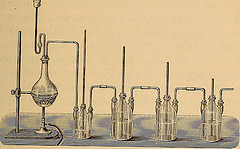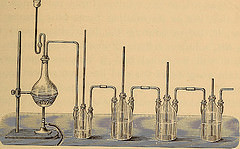Chemistry – How to Draw and Use Lewis Electron Dot Symbols in Chemistry

The drawing of Lewis dot symbols is a useful way to show the position and number of valence electrons in an atom. Remember, the valence electrons are the electrons in the outermost energy level of an atom and are instrumental in the bonding process. But an even better use for electron dot symbols is to join them together to form the Lewis structures of molecules or polyatomic ions.
However, the purpose of Lewis structures is not to show the three dimensional shape of a molecule or polyatomic ion. The purpose of Lewis structures is to show the number and kinds of bonds, and the order in which the atoms or ions are connected in the molecule or polyatomic ion. Many of these structures are simple and can be determined by inspection. While, others are a bit more complicated and require some thinking.
Simple Molecules
Many covalent compounds can be drawn by inspection using the valence electrons and the knowledge that covalent bonds are shared bonds. Just determine the Lewis dot structures of the atoms and the number of bonds for each atom. Then pair up the available electrons for the covalent bonds and draw the molecule.
Although, many molecules can be drawn by inspection others require the use of a few rules to help put them together. So, read the following rules carefully and think.
Complex Compounds
Step One Determine the “skeleton” for the molecule or polyatomic ion.
1. The least electronegative atom is the central atom, except hydrogen which is always a terminal atom.
2. Oxygen atoms do not bond with each other except in O2 and O3 molecules; peroxides; and super peroxides.
3. In oyxacids (ternary acids), hydrogen usually bonds to the oxygen instead of the central atom.
4. For those that have more than one central atom, the most symmetrical skeletons possible are used.
Step Two Calculate the number of electrons being shared (bonding electrons).
1. Determine the total number of electrons needed for each atom to complete its octet or duet (N).
2. Determine the total number of valence electrons already available (A). Remember to add electrons for negative charges and subtract electrons positive charges.
3. Subtract the electrons available from the electrons needed to get the number or electrons shared (S). S = N – A
4. Divide the shared (S) by two for the number of bonds in the molecule or polyatomic ion. S/2 = bond pairs
Step Three Place the bonding electrons in the skeleton as shared pairs.
1. Place one pair of electrons between each pair of bonded atoms.
2. If the central atom does not have a complete octet add double or triple bonds as needed.
NOT ALL ELEMENTS FORM MULTIPLE BONDS ONLY C, N, O, P, and S!!
Step Four Place the leftover electrons (A – S) in the skeleton as lone pairs.
1. Place lone pairs about each terminal atom to complete the octet rule.
2. Leftover electron pairs are placed on the central atom.
3. If the central atom is from the third or higher period, it can accommodate more than four electron pairs (expanded valance).
Although the above rules will help you with Lewis structures, the key to drawing Lewis structures is practice, practice and more practice. So, I invite you to learn more about chemistry at Mr. Causey’s World or http://yourCHEMcoach.com

Well written post on chemistry.